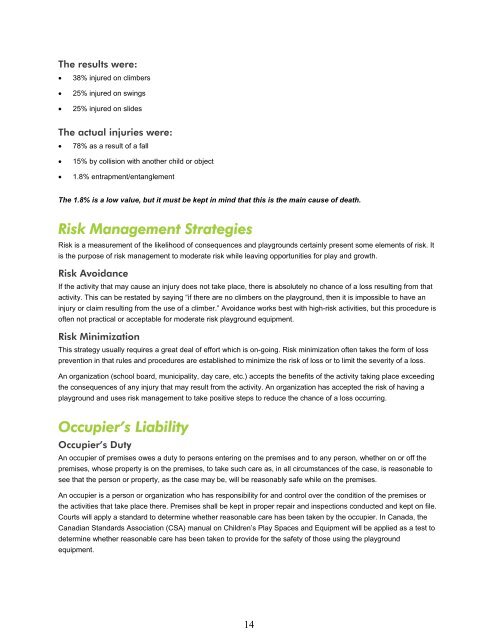Public Playground Safety - Western Financial Group Insurance ...
Public Playground Safety - Western Financial Group Insurance ...
Public Playground Safety - Western Financial Group Insurance ...
Create successful ePaper yourself
Turn your PDF publications into a flip-book with our unique Google optimized e-Paper software.
The results were:<br />
38% injured on climbers<br />
25% injured on swings<br />
25% injured on slides<br />
The actual injuries were:<br />
78% as a result of a fall<br />
15% by collision with another child or object<br />
1.8% entrapment/entanglement<br />
The 1.8% is a low value, but it must be kept in mind that this is the main cause of death.<br />
Risk Management Strategies<br />
Risk is a measurement of the likelihood of consequences and playgrounds certainly present some elements of risk. It<br />
is the purpose of risk management to moderate risk while leaving opportunities for play and growth.<br />
Risk Avoidance<br />
If the activity that may cause an injury does not take place, there is absolutely no chance of a loss resulting from that<br />
activity. This can be restated by saying “if there are no climbers on the playground, then it is impossible to have an<br />
injury or claim resulting from the use of a climber.” Avoidance works best with high-risk activities, but this procedure is<br />
often not practical or acceptable for moderate risk playground equipment.<br />
Risk Minimization<br />
This strategy usually requires a great deal of effort which is on-going. Risk minimization often takes the form of loss<br />
prevention in that rules and procedures are established to minimize the risk of loss or to limit the severity of a loss.<br />
An organization (school board, municipality, day care, etc.) accepts the benefits of the activity taking place exceeding<br />
the consequences of any injury that may result from the activity. An organization has accepted the risk of having a<br />
playground and uses risk management to take positive steps to reduce the chance of a loss occurring.<br />
Occupier’s Liability<br />
Occupier’s Duty<br />
An occupier of premises owes a duty to persons entering on the premises and to any person, whether on or off the<br />
premises, whose property is on the premises, to take such care as, in all circumstances of the case, is reasonable to<br />
see that the person or property, as the case may be, will be reasonably safe while on the premises.<br />
An occupier is a person or organization who has responsibility for and control over the condition of the premises or<br />
the activities that take place there. Premises shall be kept in proper repair and inspections conducted and kept on file.<br />
Courts will apply a standard to determine whether reasonable care has been taken by the occupier. In Canada, the<br />
Canadian Standards Association (CSA) manual on Children’s Play Spaces and Equipment will be applied as a test to<br />
determine whether reasonable care has been taken to provide for the safety of those using the playground<br />
equipment.<br />
14


